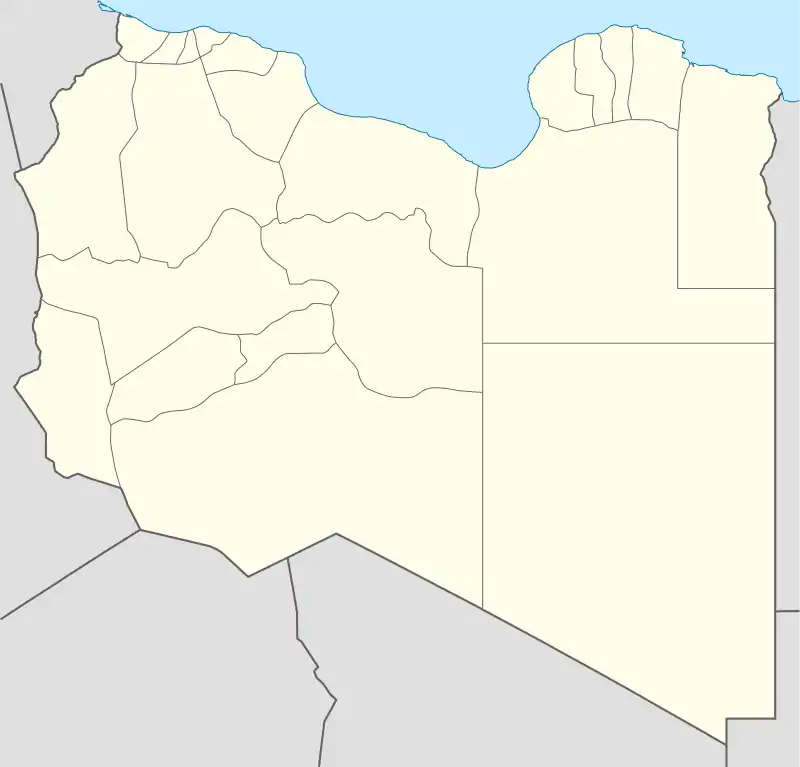Zawila
Zawila (also spelled Zuila, Zweila, Zwila, Zawilah, Zuwayla or Zuweila) is a village in southwestern Libya. During the Middle Ages, it was the capital of the Fezzan region.
Zwila
زويلة Zuila, Zweila | |
|---|---|
Town | |
 Zwila Location in Libya | |
| Coordinates: 26°10′00″N 15°07′00″E | |
| Country | |
| Region | Fezzan |
| District | Murzuq |
| Population (2006)[1] | |
| • Total | 4,018 |
| Time zone | UTC+2 (EET) |
When Uqba ibn Nafi passed through the area in 46 A.H. (666/67 CE), there was no city there. Zawila was settled probably in the early 8th century. It very quickly became the chief town of the region.[2]
During its early history, it was dominated by the Hawwara Berbers, who mostly followed Ibadism. The Abbasids under Muhammad ibn al-Ash'ath al-Khuza'i captured the town in 762/63, and killed its Ibadi ruler, Abd Allah ibn Hayyan, but Ibadism persisted in Zuwila and the Fezzan in general.[2] The town then became part of the Rustamid domains, albeit lying on the extreme eastern periphery of their realm.[2] After the demise of the Rustamid dynasty at the hands of the Fatimids, in 918/19 Zawila became the capital of another independent Ibadi state, under the Berber Banu Khattab dynasty, which lasted until 1176/77.[2]
During this period, Zawila enjoyed considerable prosperity, both from agriculture, with the aid of irrigation works, as well as from its privileged position on the trans-Saharan trade networks. It was particularly notable as a centre of the Black African slave trade, as well as for its production of a leather variety named after the town.[2] The Fatimids recruited soldiers from the area, whence the name of the Bab Zuwayla gate in Cairo.[2] Alongside the Berbers, the town was inhabited also by a free black population, possibly of Toubou or Kanuri origin.[2]
The Kanem Empire started raiding the region in the 11th century, but the Banu Khattab held power until they were conquered by an Armenian Mamluk, Sharaf al-Din Qaraqush, who, coming from Egypt, conquered the region in the 1170s. The instability created by Qaraqush was exploited by the Kanem, who by the end of the 12th century had seized control of the Fezzan, establishing a new capital at Traghan, a few miles west of Zawila.[2]
Kanem rule lasted through the 13th century, until the local governors, the Banu Nasur, established their own independent state.[2] In the early 15th century, Fezzan came under the influence of the Hafsid dynasty, and Zawila probably once again became the regional capital.[2] At the same time, however, the disruption of the trans-Saharan trade routes affected the town's prosperity, and it lost its importance and rank of capital. When the Awlad Muhammad dynasty established Murzuk as their capital to the west of Zawila, the trade routes were diverted there, and Zawila fell into obscurity.[2]
References
- Amraja M. el Khajkhaj, "Noumou al Mudon as Sagheera fi Libia", Dar as Saqia, Benghazi-2008, p.121.
- Vikør, K. S. (2002). "Zawīla". In Bearman, P. J.; Bianquis, Th.; Bosworth, C. E.; van Donzel, E. & Heinrichs, W. P. (eds.). The Encyclopaedia of Islam, New Edition, Volume XI: W–Z. Leiden: E. J. Brill. p. 466. ISBN 978-90-04-12756-2.
